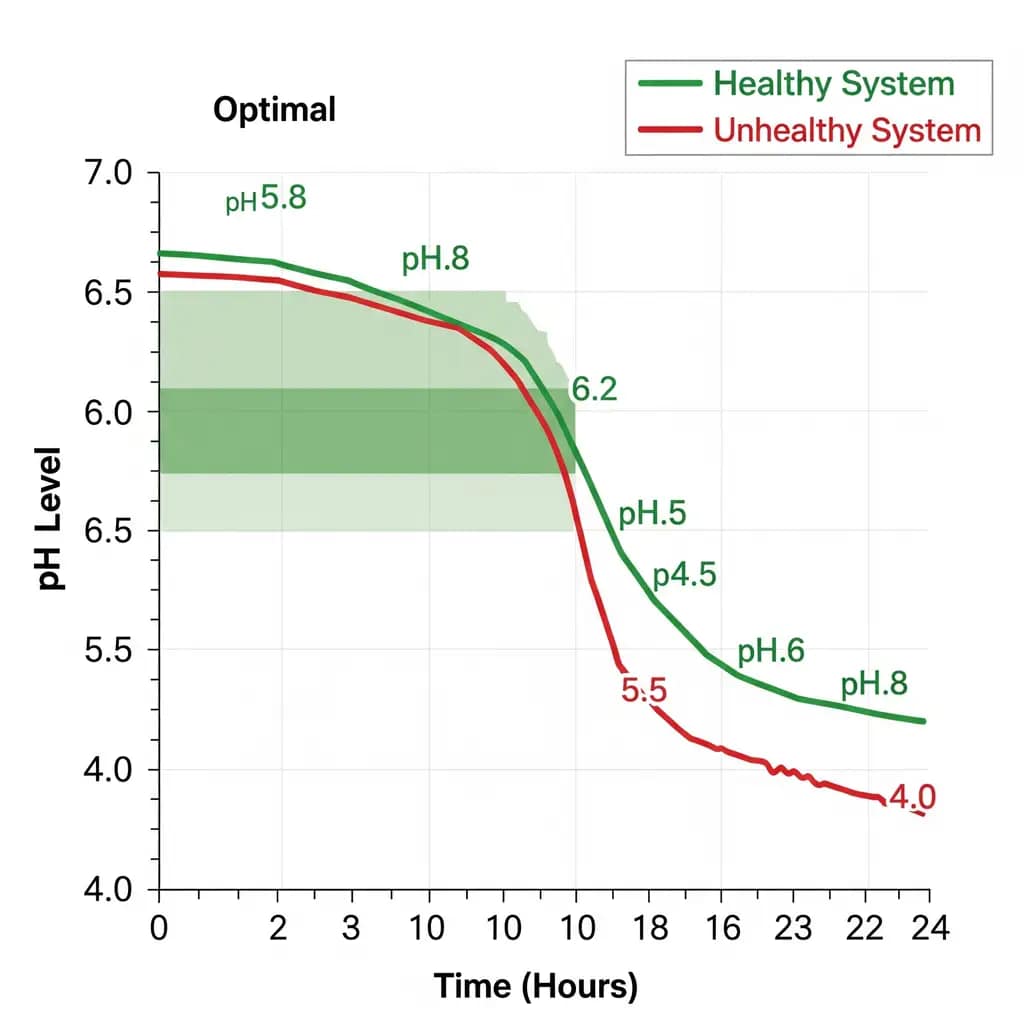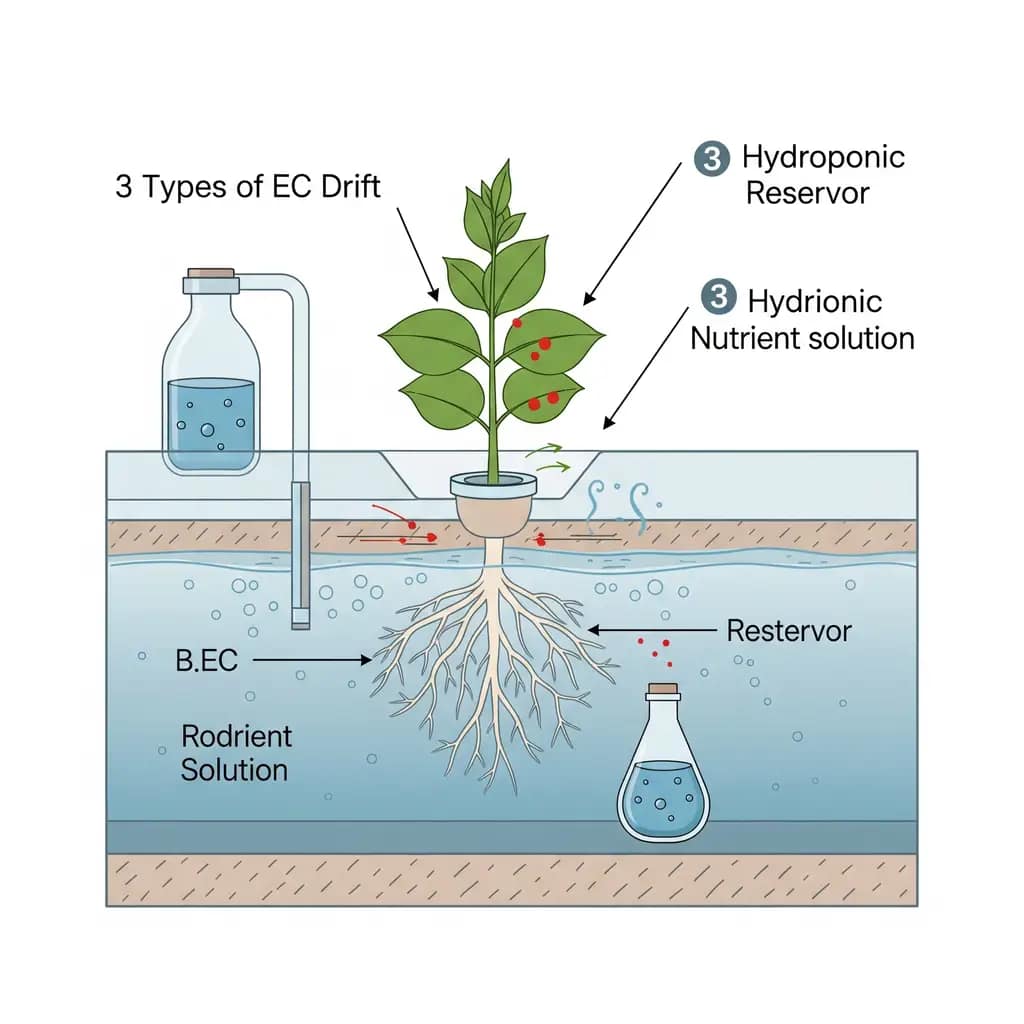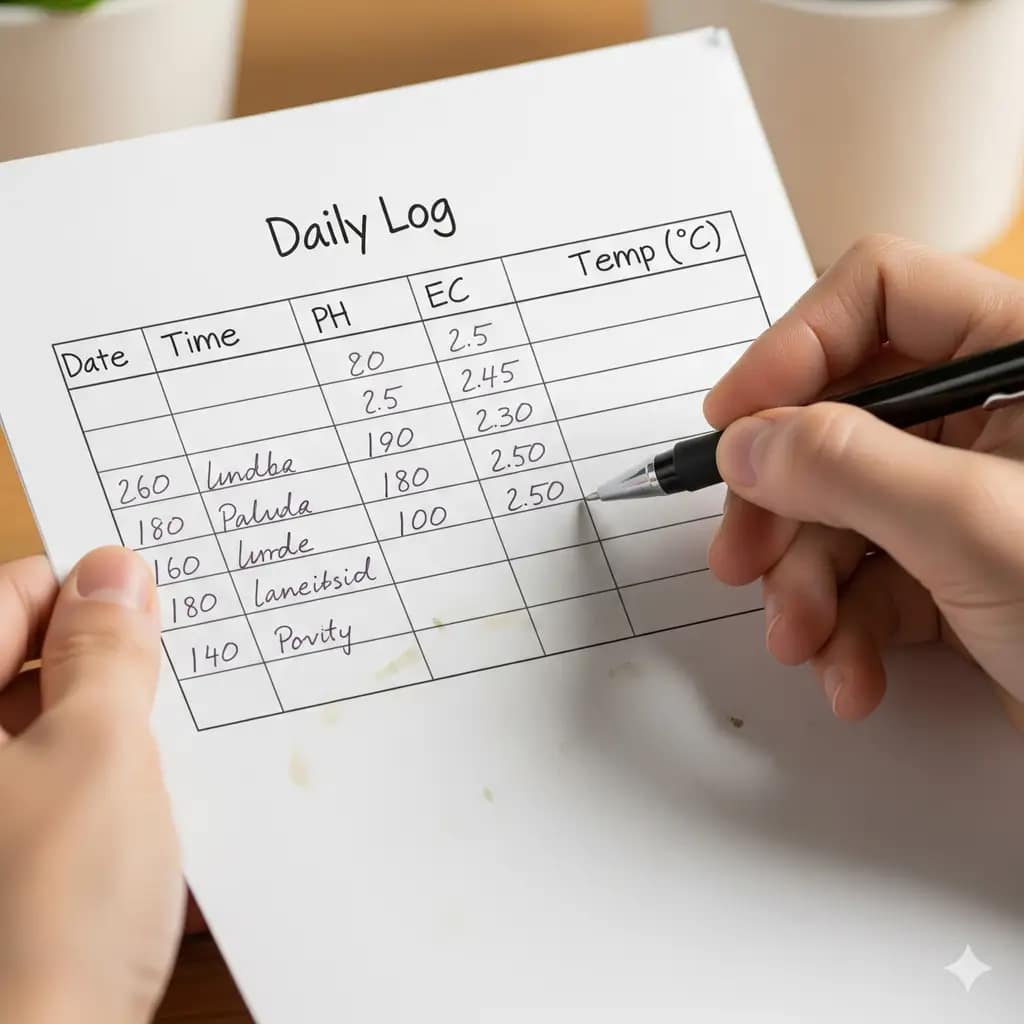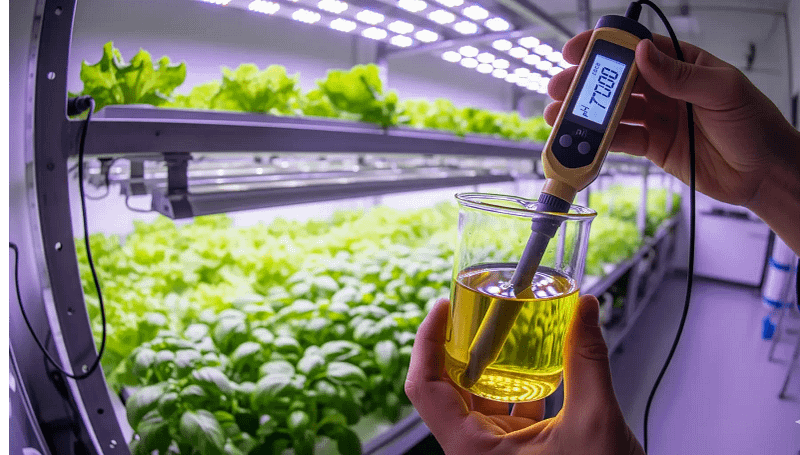I once trusted a fresh hire with a brand-new $30 pH meter. It was 2017, the start of a massive 200-plant clone run. What could go wrong? My mistake wasn’t the meter; it was the two-dollar calibration solution that was contaminated. We ran with it for two weeks, blissfully unaware. My carefully balanced reservoir, which should have been at pH 5.8, was actually a scorching pH 8.1. Within a week, the leaves were yellowing, the roots were browning, and my entire crop was locked out of nutrients. The pH meter was lying to me. It said “perfect,” but it was a drunken navigator steering the ship onto the rocks. I killed 200 clones, an entire strain lost to a two-dollar error. This isn’t just about numbers; it’s about life and death in a closed system. And it’s a lesson I will never forget. Learn from my mistake. Don’t trust the machine without verifying its truth. WARNING: Cannabis cultivation remains federally illegal. Information for legal jurisdictions only. Product links for ‘novelty research’ purposes.
Probe Survival Guide: Calibration That Doesn’t Lie
Listen up, number nerds. An uncalibrated meter is a drunken navigator. It tells you the world is fine while you’re steering your crop toward a catastrophic pH crash or nutrient lockout. Proper calibration is not a suggestion. It is the first commandment of hydroponics. Without a trustworthy reading, all your nutrient-balancing math is worthless.
The Sacred Ritual: Calibration Frequency and Technique
My labs run on the principle of metrology, the science of measurement. For hydroponics, this translates to one iron-clad rule:
Calibrate your pH and EC meters every 7-10 days1. You don’t have a choice. The thin, sensitive glass membranes on a pH probe are like tiny electrodes that get poisoned over time by minerals, nutrients, and microbes. You need to reset them constantly.
Here’s my pro-hacker protocol for a calibration that won’t betray you:
- Prep Your Solutions: Use fresh calibration solutions. Don’t reuse them. Ever. I’ve seen contaminated bottles from growers who thought they were “saving money.” That time I trusted a $10 meter cost me a crop; trusting a used solution will cost you the same, but it’ll be a slower, more painful death.
- Rinse Between Buffers: After calibrating with a pH 7.0 buffer, rinse the probe thoroughly with distilled water before moving to the 4.0 buffer. This prevents cross-contamination. I keep a dedicated spray bottle of distilled H₂O right on my bench for this.
- The Storage Hack: Don’t buy a pre-made storage bottle. Make your own. Grab a small mason jar and fill it with pH 4.0 solution. This will keep your electrode happy between uses. It’s a simple, cheap, and effective way to ensure your probe’s membrane stays hydrated and ready for action.
Probe Care 101: The Daily Discipline
Calibration is worthless if you neglect your probe. Think of it like a surgeon’s scalpel. It has to be clean.
- Rinse After Every Use: Always, always rinse your probe with distilled water after taking a measurement. Don’t let nutrient residue dry on the glass bulb. That buildup will throw your readings into chaos.
- Keep It Wet: A dry electrode is a dead electrode. I always store my probes in the correct storage solution or, in a pinch, in a pH 4.0 calibration solution. Never use tap water.
- The 90-Second Soak: If your readings are drifting wildly or seem unstable, a quick 90-second soak in a commercial probe cleaner can work miracles. It breaks down the mineral buildup that’s blinding your sensor.
Drift Decoder: Reading Your System’s Secret Language
Your pH and EC meters are not just gauges; they’re microphones listening to the secret language of your plants. pH drift is like a plant screaming for help. EC drift is its body temperature changing. You just have to know how to listen.
The pH Dance: Why Your Readings Lie at Dawn

Mind-Blowing Insight #1: Your pH will always read slightly differently at dawn versus dusk. Why? Because plants don’t absorb ions at a constant rate. They’re living organisms on a cycle. At night, they respire and release carbon dioxide, which forms carbonic acid in your reservoir. This drives pH down. During the day, they’re photosynthesizing like mad and pulling in ions, causing a slow drift upward. That’s normal. That’s a healthy plant.
The problem? When the drift is extreme.
- A daily pH swing of more than 0.5 is a red flag2. That’s a sign of a nutrient imbalance. Your plants are struggling to absorb a particular ion, throwing off the delicate acid-base balance of your reservoir. This is the time to check your nutrient ratios, not just your pH.
- If your pH crashes (drops rapidly), it’s often a sign of a fungal attack or root disease. Dead roots release organic acids. A sharp, unexplainable pH drop is often the first and only warning sign you get before a massive root rot outbreak.
The EC Ebb and Flow: What Your Plants Are Eating

Your EC is the concentration of total dissolved salts in your solution3. It’s a direct measure of what’s available for your plants to eat. EC drift is a natural part of the grow cycle.
- EC rises, water level drops: Your plants are thirsty. They’re drinking more water than they are eating nutrients. This is common in hot, dry conditions. Solution: Top off your reservoir with pure, pH-adjusted water.
- EC drops, water level drops: Your plants are feasting. They’re eating more nutrients than they’re drinking water. This is a sign of aggressive growth. Solution: Top off with a fresh, half-strength nutrient solution to replenish what they’ve consumed.
- EC and water level both drop at the same rate: A perfectly balanced system. Your plants are taking in water and nutrients in perfect harmony. Don’t touch a thing. Just log the data and appreciate the masterpiece.
Mind-Blowing Insight #2: EC drift is not a problem. It’s a diagnosis. You don’t “fix” EC drift; you simply observe what your plants are doing and respond accordingly.
The Math of Rescue: Precise Adjustment Formulas
You’ve read your meters. You’ve decoded the drift. Now it’s time for the math. Don’t eyeball it. Eyeballing it is a calibration error waiting to happen. Use these simple formulas to make precise, surgical adjustments to your reservoir.
The pH Adjustment
You’re aiming for a slow, gentle correction. Don’t shock your roots with a massive pH swing. My rule: make small, incremental changes, targeting no more than a 0.3 change per day.
- The pH Down Calculation:
- Measure your current pH.
- Use a small beaker to add a known amount of pH Down to a liter of your reservoir water.
- Measure the new pH and note the difference.
- Scale that ratio up to your total reservoir volume.
Example: Your 40-gallon reservoir is at pH 6.8, and you want to get to 6.2. In a 1-liter sample, 1ml of pH Down dropped the pH by 0.5. Your reservoir is 151.4 liters. (151.4 L / 1 L) * (1 ml / 0.5 pH) * (0.6 pH change needed) = 181.68 ml of pH Down. Yes, the math is that simple. And that precise.
The EC Adjustment
You’re not guessing. You’re calculating what your plants have eaten and replacing it.
- The EC Up Calculation:
- Measure your target EC.
- Measure your current EC.
- Find the difference.
- Use a nutrient calculator (there’s one on our site! [Internal Link: Nutrient calculators]) or a commercial feeding chart to determine how many ml/L of your base nutrient blend it takes to raise the EC by that amount.
- Scale it up to your reservoir volume.
Mind-Blowing Insight #3: Water evaporation concentrates your nutrients, so when you top off with pure water, your EC will drop. That’s not a bug; it’s a feature. Embrace it.
Why Daily Logs Save Crops
You can’t manage what you don’t measure. I’ve seen it time and again: a grower panics about a problem they can’t diagnose because they have no baseline data. Drift happens. But without a log, you can’t tell the difference between a natural drift and a catastrophic one. A daily log is your flight recorder. It’s your truth.
The Power of a Template
A simple daily log allows you to spot patterns before they become problems. You’ll see pH slowly crashing before the first leaf yellows. You’ll see EC spiking before your roots start to burn. My free template [Internal Link: Printable hydro setup checklist] includes:
- Date/Time: When you took the reading.
- pH/EC/Temp: The raw data.
- Reservoir Level: How much water was lost.
- Notes: Your observations.
Logging doesn’t take long. A few minutes a day. But those few minutes are the difference between a minor adjustment and a lost crop.
Gear That Never Betrays You
This is my armory. The meters, solutions, and adjusters that have survived years in a commercial lab. They are not the cheapest. They are the ones that work. Every single one of these tools is here because of a failure. A cheap meter. A bad calibration. These are the tools that never betrayed me again.
- Apera AI311 pH/EC Meter
- Fixes: Calibration drift nightmares and dual-probe chaos. This all-in-one meter is an absolute tank.
- Battle Tested: 1,200+ readings a month since 2020. My old meters couldn’t handle that.
- Price: 💸💸💸 (Your crop’s insurance policy).
- Bluelab pH & EC Pen Combo
- Fixes: Inaccurate readings from cheap pens and poor battery life. These are the workhorses of the industry.
- Battle Tested: Dropped in reservoirs, left on benches, and still reading true after three years. They are that good.
- Price: 💸💸 (The professional’s daily driver).
- General Hydroponics pH Up/Down
- Fixes: Rapid pH crashes and chemical shock from poor-quality adjusters. These are buffered and slow-acting, designed for a gentle touch.
- Battle Tested: A staple in every grow I’ve ever run. Consistent, reliable, and predictable.
- Price: 💸 (The foundational chemistry).
- Apera 7.0 & 4.0 Calibration Solutions
- Fixes: Unreliable readings from old, cheap, or contaminated calibration solutions. These are the absolute truth.
- Battle Tested: Used a new bottle for every calibration, and never saw a drift error again.
- Price: 💸 (Cheaper than one lost plant).
When Natural Adjustments Work (And When They Kill)
I’ve heard it all. “Just use vinegar.” “Baking soda is a natural pH up.” These are fine for a bucket in a window, but in a closed, recirculating system, they are poison.
- Vinegar/Citric Acid (The Great Lie): Yes, they will drop your pH. For about an hour. Then they break down and your pH will spike uncontrollably. You’ll be chasing pH for the rest of your grow. Don’t do it.
- Baking Soda (The Slow Poison): Baking soda is sodium bicarbonate. It will raise your pH, but it’s pure salt. All that sodium will build up in your reservoir, eventually poisoning your plants and causing nutrient lockout. Do you want to fix your pH, or do you want to build a salt lick? The answer should be obvious.
EC ↔ PPM: Cutting Through Conversion Chaos
This is a point of constant chaos for new growers. What’s the difference between EC and PPM? Which scale is right? The answer is: both. But they are not the same.
EC (Electrical Conductivity) is the raw, scientific measurement of how well your solution conducts electricity. It’s measured in micro- or milli-Siemens (mS/cm). This is a direct, standardized measurement4.
PPM (Parts Per Million) is a fictional number. It’s a conversion. A measurement of the total dissolved solids (TDS) based on an arbitrary conversion factor. It’s useful for marketing but dangerous for precision.
- The 500 Scale: Used by companies like Hanna and Bluelab. They assume
EC (mS/cm) * 500 = PPM. - The 700 Scale: Used by companies like Truncheon. They assume
EC (mS/cm) * 700 = PPM.
This is why your meters will always give you different numbers. You have to pick a scale and stick to it. I always use EC. It’s the one true measurement. If you have to use PPM, verify which scale your meter is on and write it down. This is an easy place for a catastrophic conversion error to sneak in.
Conclusion: The Path to Precision

You are not a gardener; you are a hydroponic architect5. You are building an ecosystem from scratch, and precision is your blueprint. A simple daily log, a calibrated meter, and a deep understanding of what’s happening in your reservoir will transform your grow from a chaotic gamble into a repeatable, scientific success.
This guide is your first step. It’s a road map through the chaos, a guide to listening to your plants, and a cheat sheet for the math you need to survive. Don’t let a two-dollar mistake cost you an eight-thousand-dollar crop. The data doesn’t lie. Your meter might, but you now know how to stop it.
FAQs
How often should I calibrate my pH and EC meters?
You should calibrate your pH and EC meters every 7-10 days. The sensitive probes degrade over time due to mineral buildup and nutrient residue. Regular calibration is the first commandment of hydroponics, as it ensures your readings are accurate and prevents a catastrophic pH crash or nutrient lockout.
What is the difference between EC and PPM, and which should I use?
EC (Electrical Conductivity) is a raw, scientific measurement of how well your solution conducts electricity. PPM (Parts Per Million) is a converted number based on an arbitrary scale. You should always use EC, as it is a standardized, direct measurement. If you must use PPM, be sure you know whether your meter is on the 500 or 700 scale to avoid a catastrophic conversion error.
What can I learn from my plants’ daily pH drift?
A plant’s pH will naturally drift throughout the day. A healthy pH swing of no more than 0.5 is normal. However, a daily pH swing of more than 0.5 is a red flag, indicating a nutrient imbalance or a problem in your system. This is your plant’s way of telling you it’s struggling to absorb a specific ion.
What is the most common cause of a contaminated calibration solution?
The most common cause of a contaminated calibration solution is reusing it after a single use or not rinsing your probe with distilled water before moving to the next buffer. Once a solution is exposed to air or a used probe, it loses its accuracy. To prevent contamination, you should use fresh, clean calibration solutions for every calibration.
How do I fix a hydroponic reservoir with an EC that is too high?
If your EC is too high, it’s a sign that your nutrient solution is too concentrated and your plants are drinking more water than they are eating nutrients. To fix this, simply dilute your reservoir with plain, pH-adjusted water until you reach your target EC.
What is a common mistake in probe maintenance?
A common mistake is storing a probe in tap water or letting it dry out. Tap water has minerals that will crust the probe’s glass bulb, and distilled water will leach the internal electrolyte, effectively killing it. Always store your probe in a proper storage solution to keep the electrode hydrated and ready for action.
Is it safe to use household products like vinegar or baking soda to adjust pH?
No, it is not. While they will temporarily adjust your pH, they are not a stable solution. Vinegar will break down and cause your pH to spike uncontrollably, and baking soda will build up sodium in your reservoir, eventually poisoning your plants and causing a nutrient lockout. You should always use a buffered solution like General Hydroponics pH Up/Down.
Disclaimer: All product recommendations and technical data are based on our experience and research. Always conduct your own tests before applying any new methods to your crop.
Key References:
- Oklahoma State University Extension. “Electrical Conductivity and pH Guide for Hydroponics”
- Oklahoma State University Extension. “Home Hydroponics”

